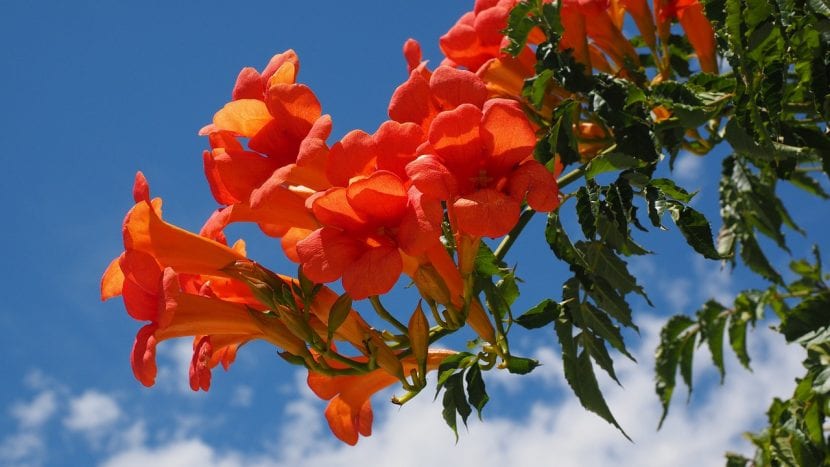
La Campsis radicals, known by the common name Trumpet Creeper, It is a very fast growing plant with such beautiful flowers that it can be used to cover pergolas, walls or walls. But not only that, but it also supports pruning very well, so it can also be potted and placed next to a small lattice on the balcony, which will cover flowers sooner than expected.
Do you want to know more about her? If so, don't miss this article 🙂.
Campsis radicans characteristics

Campsis radicals var. flava
Our protagonist is a climbing plant whose species, Campis radicals (before Bignonia radicals) belongs to the botanical family Bignoniaceae. It is native to the southeastern United States. It is characterized by having a rapid growth until it reaches 10 meters in height. The stem is woody and has abundant aerial roots that help to fixate.
The leaves are pinnate, with 9 to 11 leaflets, oblong to ovate, with serrated edges, pubescent and green. They behave as deciduous, that is, they fall off in autumn and sprout again in spring. Flowers, undoubtedly its main attraction, sprout from summer to fall and they are grouped in inflorescences in the shape of a red or yellow trumpet (the variety »Flava»).
How do you take care of yourself?

La Campsis radicals it is a plant suitable for beginners. In fact, you just have to take into account the following:
- Location: outdoors, in full sun or in semi-shade.
- Soil or substrate: it is not demanding, but it is important that it has good drainage.
- Subscriber: in spring and summer it can be fertilized with a universal fertilizer for flowering plants, or with guano in liquid form. The instructions specified on the packaging must be followed.
- Planting or transplanting time: in spring, when the risk of frost has passed.
- Pruning: the stems that have given flower at the end of winter and the withered flowers must be removed.
- Multiplication: by cuttings of hard or soft wood in autumn, seeds by stratification, or by angled of stems in spring.
- Rusticity: supports frosts down to -5ºC.
What did you think of this plant?
I would like to put a campsis radicans in a large pot and put orange clivias around it to give the plant volume underneath and not look so poor ... Would it be a good combination? The part of the campsis that is going to climb is full sun but the pot is in shadow behind a wall ...
Hi Esther.
I do not recommend it. Campsis roots develop fast, and clivias would not have time to grow. In fact, it is possible that they would end up dying since the competition that would be created between both plants would be enormous.
Yes you could put bulbous, type tulips, freesias, hyacinths. In short, one of those that only bloom at some time of the year. Their space and nutrient requirements are very low, so they could flourish without any problem. You could even plant summer bulbs y spring bulbs, to have a flower longer.
Regards!